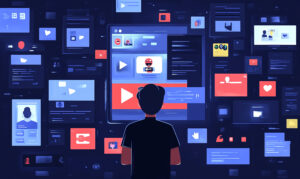Discovering the Most Effective AI-Powered Content Optimization Tools
In the rapidly evolving world of content creation, AI tools have emerged as game-changers, revolutionizing the way creators produce, optimize, and distribute their content. As we navigate through 2024, the question on every content creator’s mind is: what are the best AI tools currently available to streamline the content creation process, save time, and ultimately boost views, subscribers, and followers across various platforms?
To shed light on this topic, we had the privilege of speaking with Nikki Saunders, a seasoned content creator and podcaster who has dedicated a significant amount of time to researching and testing various AI tools. Nikki’s insights provide valuable guidance for content creators seeking to leverage the power of AI in their creative endeavors.
We strongly recommend that you check out our guide on how to take advantage of AI in today’s passive income economy.
Table of Contents
Chat GPT: The Go-To AI Tool for Content Creators
When asked about the main AI tools that have proven to be invaluable in her content creation journey, Nikki enthusiastically mentioned Chat GPT as her go-to tool. With its recent updates, particularly the integration of Dolly 3, Chat GPT has become an even more powerful asset for content creators. The ability to generate images and modify them directly within the chat interface has opened up new possibilities for creating visually compelling content.
One of the standout features of Dolly 3 is its capability to incorporate text into images seamlessly. For instance, if you wanted to create a thumbnail with the text “Think Media,” you can simply input that information, and Dolly 3 will generate an image with the specified text. This level of customization and ease of use has made Chat GPT an indispensable tool in Nikki’s daily content creation workflow.
Opus Clip: Repurposing Long-Form Videos with AI
Beyond Chat GPT, Nikki highlighted Opus Clip as another favorite AI tool for content creators. Opus Clip excels at repurposing long-form videos by clipping them into shorter segments, ranging from 10 to 47 clips, depending on the length of the original video. Whether you provide a YouTube link or upload a video directly, Opus Clip efficiently processes the content and adds captions, allowing for further customization with logos and other elements.
One exciting update in the pipeline for Opus Clip is the integration of b-roll footage. Based on the AI’s analysis of the content, it will intelligently add relevant b-roll to enhance the visual appeal of the clips. This feature, combined with the ability to include emojis and other customizations, sets Opus Clip apart from other repurposing AI tools in terms of selection and overall effectiveness.
The Significance of Content Optimization Tools in Content Strategy
Nikki emphasized the significance of Content Optimization Tools in her content strategy, as they play a crucial role in improving results and expanding the reach of her content. When asked about other AI tools that content creators should be paying attention to, Nikki introduced Fire Cut, a plugin for Premiere Pro that has been making waves in the industry.
Fire Cut offers a range of impressive features that streamline the content creation process. For podcasts with multiple camera angles, Fire Cut automatically cuts between the angles in a matter of minutes, saving creators a significant amount of time in post-production. Additionally, the plugin generates captions, performs automatic zoom in and out effects, and adds chapters to the video, enhancing the overall viewing experience.
One notable feature of Fire Cut is its ability to create chapters that take up the entire screen, similar to the style popularized by Ali Abdaal’s videos. This attention-grabbing format helps keep viewers engaged and adds a professional touch to the content. Moreover, Fire Cut intelligently removes filler words like “um” and “huh,” ensuring a polished final product.
Balancing AI-Generated Content with Human Touch
When it comes to repurposing content using tools like Opus Clip, Nikki shared her workflow and the importance of striking a balance between AI-generated content and human touch. In one scenario, after going live on YouTube, Nikki immediately took the link and fed it into Opus Clip, which generated around 20 different clips. While not all of the clips were usable, she found that three or four of them were suitable for repurposing.
Nikki’s approach involves two use case scenarios. In the first case, she takes a clip directly from Opus Clip and posts it on YouTube Shorts, directing viewers back to the original live video. In the second case, she imports the AI-generated clip into her video editor and enhances it with additional pictures and visual elements. This human touch adds a layer of personalization and style that resonates with her audience.
The clip that underwent manual editing with extra pictures performed significantly better, garnering a few thousand more views compared to the one posted straight from Opus Clip. This highlights the importance of striking a balance between leveraging AI tools and infusing the content with a human touch. While AI-powered Content Optimization Tools offer incredible assistance, they still require guidance and refinement to truly reflect the creator’s unique style and engage their audience effectively.
Nikki’s insights underscore the notion that AI is not perfect and still needs human intervention to achieve the best results. Content Optimization Tools serve as powerful aids in the content creation process, but they should be viewed as complementary to the creator’s vision and expertise rather than a complete replacement.
Navigating the Future of Content Creation with AI Tools
As content creators navigate the ever-evolving landscape of AI tools, it is crucial to stay informed about the latest advancements and experiment with different Content Optimization Tools to find the ones that best suit their needs and creative style. From Chat GPT and Opus Clip to Fire Cut and beyond, the possibilities for enhancing content creation workflows and maximizing audience engagement are vast and exciting.
Embracing AI-powered Content Optimization Tools while maintaining a human touch is the key to success in the content creation game of 2024 and beyond. By leveraging these tools strategically and infusing their unique perspective and creativity, content creators can multiply their content’s reach, attract more views, subscribers, and followers, and ultimately establish a strong presence across various platforms.
As we move forward in this AI-driven era of content creation, it is essential for creators to stay curious, adaptable, and open to exploring new tools and techniques. The insights shared by Nikki Saunders serve as a valuable starting point for content creators looking to optimize their workflows and elevate their content to new heights. By embracing the power of AI while preserving their authentic voice, creators can thrive in this exciting and transformative time in the world of content creation.
FAQs:
What is a content optimization tool?
A content optimization tool is a software or platform that helps content creators enhance their content to achieve better visibility, engagement, and overall performance. These tools utilize artificial intelligence, machine learning, and data analysis to provide insights and recommendations on how to improve various aspects of content, such as keywords, structure, readability, and relevance to the target audience.
Content optimization tools can assist in identifying trending topics, suggesting relevant keywords, analyzing competitor content, and providing actionable tips to make your content more appealing to both search engines and readers. By leveraging these tools, content creators can save time, streamline their workflow, and create content that resonates with their audience while ranking higher in search engine results pages (SERPs).
What is the best tool for optimization?
Determining the best tool for content optimization depends on your specific needs, preferences, and budget. However, some of the most popular and highly regarded content optimization tools in the market include:
- Chat GPT: A versatile AI-powered tool that can assist in generating ideas, writing content, and optimizing it for search engines and user engagement.
- Opus Clip: An AI-driven video repurposing tool that clips long-form videos into shorter, engaging segments and adds captions, logos, and other customizations.
- Fire Cut: A plugin for Premiere Pro that automates video editing tasks, such as cutting between multiple camera angles, generating captions, and adding chapters.
- SEMrush: A comprehensive digital marketing toolkit that offers keyword research, competitor analysis, and content optimization features.
- Ahrefs: Another popular SEO and content optimization tool that provides keyword research, content gap analysis, and backlink analysis.
Ultimately, the best tool for optimization will depend on your specific content creation needs and goals. It’s advisable to explore different options, read reviews, and take advantage of free trials or demos to find the tool that aligns best with your requirements.
How can I optimize my content?
To optimize your content, you can follow these key steps:
- Conduct keyword research: Identify relevant keywords and phrases that your target audience is searching for and incorporate them naturally into your content.
- Analyze competitor content: Study the content of your top-ranking competitors to understand what works well in your niche and identify opportunities to create better, more comprehensive content.
- Optimize your headline and meta description: Craft compelling, keyword-rich headlines and meta descriptions that entice users to click through to your content from search results.
- Structure your content effectively: Use header tags (H1, H2, H3), short paragraphs, bullet points, and images to make your content easy to read and scan.
- Ensure readability: Write in a clear, concise manner and avoid jargon or overly complex language to make your content accessible to a wide audience.
- Include internal and external links: Link to relevant, authoritative sources within your content and to other pages on your website to improve user experience and establish topic clusters.
- Optimize for featured snippets: Structure your content in a way that answers common questions or provides step-by-step instructions to increase your chances of appearing in Google’s featured snippets.
- Leverage content optimization tools: Use AI-powered tools like Chat GPT, Opus Clip, or Fire Cut to streamline your content creation process and ensure your content is optimized for search engines and user engagement.
How to write SEO optimized content with AI?
To write SEO optimized content with AI, you can follow these steps:
- Identify your topic and target keywords using AI-powered keyword research tools like SEMrush or Ahrefs.
- Input your topic, keywords, and any other relevant information into an AI writing tool like Chat GPT.
- Allow the AI tool to generate a draft of your content, which will include the target keywords and be structured in an SEO-friendly manner.
- Review and edit the AI-generated content to ensure it meets your brand voice, style, and quality standards. Add your own insights, examples, and personal touch to make the content unique and engaging.
- Use AI-powered content optimization tools to analyze your content for readability, keyword density, and other SEO factors. Make necessary adjustments based on the tool’s recommendations.
- Include optimized headers, meta descriptions, and image alt tags to further enhance your content’s SEO performance.
- Publish your AI-assisted, SEO-optimized content on your website or blog, and promote it through various channels to attract traffic and engagement.
By combining the efficiency of AI tools with human oversight and creativity, you can create high-quality, SEO-friendly content that resonates with your target audience and ranks well in search engine results.

We strongly recommend that you check out our guide on how to take advantage of AI in today’s passive income economy.




